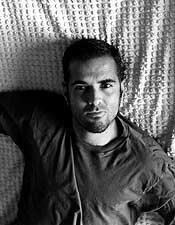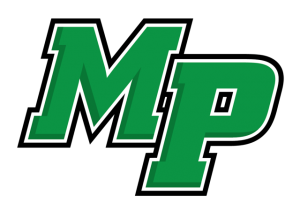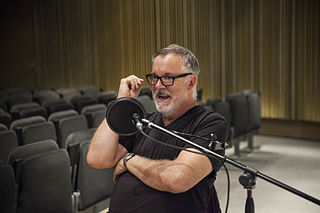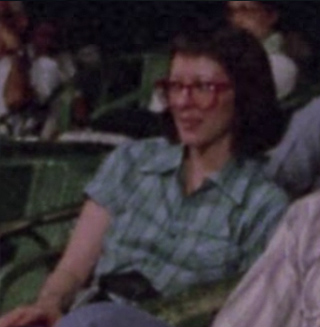
Bruce Nauman is an American artist. His practice spans a broad range of media including sculpture, photography, neon, video, drawing, printmaking, and performance. Nauman lives near Galisteo, New Mexico.

Joaquin Alberto Vargas y Chávez was a Peruvian-American painter of pin-up girls. He is often considered one of the most famous of the pin-up artists, and as one of the pioneers of airbrush art. Numerous Vargas paintings have sold and continue to sell for tens of thousands around the world.

Félix González-Torres or Felix Gonzalez-Torres was a Cuban-born American visual artist. He lived and worked primarily in New York City between 1979 and 1995 after attending university in Puerto Rico. González-Torres’s practice incorporates a minimalist visual vocabulary and certain artworks that are composed of everyday materials such as strings of light bulbs, paired wall clocks, stacks of paper, and individually wrapped candies. González-Torres is known for having made significant contributions to the field of conceptual art in the 1980s and 1990s. His practice continues to influence and be influenced by present-day cultural discourses. González-Torres died in Miami in 1996 from AIDS-related illness.

George Roussos, also known under the pseudonym George Bell, was an American comic book artist best known as one of Jack Kirby's Silver Age inkers, including on landmark early issues of Marvel Comics' Fantastic Four. Over five decades, he created artwork for numerous publishers, including EC Comics, and he was a staff colorist for Marvel Comics.

Myers Park High School is a public high school in Charlotte, North Carolina. It serves grades 9–12, and is a part of the Charlotte-Mecklenburg Schools district.

Melvin John Ramos was an American figurative painter, specializing most often in paintings of female nudes, whose work incorporates elements of realist and abstract art.
David Salle is an American Postmodern painter, printmaker, photographer, and stage designer. Salle was born in Norman, Oklahoma, and lives and works in East Hampton, New York. He earned a BFA and MFA from the California Institute of the Arts, Valencia, California, where he studied with John Baldessari. Salle’s work first came to public attention in New York City in the early 1980s.

Robert Dowd was an American artist, who also painted under the name Robert O'Dowd.

Kenneth Price was an American artist who predominantly created ceramic sculpture. He studied at the Chouinard Art Institute and Otis Art Institute in Los Angeles, before receiving his BFA degree from the University of Southern California in 1956. He continued his studies at Chouinard Art Institute in 1957 and received an MFA degree from New York State College of Ceramics at Alfred University in 1959. Kenneth Price studied ceramics with Peter Voulkos at Otis and was awarded a Tamarind Fellowship.
Bruce Metcalf is an American artist who uses different materials including wood, metal, and plexiglass for his works.

Moon Museum is a small ceramic wafer three-quarters by one-half inch in size, containing artworks by six prominent artists from the late 1960s. The artists with works in the "museum" are Robert Rauschenberg, David Novros, John Chamberlain, Claes Oldenburg, Forrest Myers and Andy Warhol.
Kyle Mosher, also known as I'm not a crook, is a Canadian-born Charlotte, North Carolina–based artist and designer known for his collage and cut-paper style.

Matt Mullican is an American artist and educator. He is the child of artists Lee Mullican and Luchita Hurtado. Mullican lives and works in both Berlin and New York City.

Ten Dollar Bill is a 1956 proto-pop art lithographic drawing by Roy Lichtenstein. Considered to be a combination of Americana art and cubism, the work is referred to as the beginning of Lichtenstein's work on pop art. Twenty-five editions of the lithograph were made by Lichtenstein, which were exhibited at several galleries. The piece is based on the design for the ten-dollar bill and has influenced several of Lichtenstein's later works. The picture has received generally favorable reception from critics, and is considered to be one of the best artistic portrayals of currency.

Todd Gray works in photography, performance and sculpture as a contemporary artist who lives and works in Los Angeles, California and Akwidaa, Ghana.
Odili Donald Odita is a Nigerian American abstract painter who lives and works in Philadelphia, Pennsylvania. His work explores color both in the figurative historical context and in the sociopolitical sense. His vibrant large-scale abstractions have been described as "showstoppers" and are considered to raise questions about race and society. Most of Odita's work is inspired by the vibrant textiles of his home country, Nigeria, mixed with patterns from Western modernity.
Jim McWilliams is an American artist and graphic designer who was active as an avant-garde performer and composer during the 1960s and 1970s.

Sara Greenberger Rafferty, is a multimedia artist working in painting, sculpture, photography, installation and performance. Her work focuses on gender and body politics in and through comedic performance. Rafferty teaches full-time at Pratt Institute and lives and works in Brooklyn, New York. Rafferty received a B.F.A. in Photography with Honors and Art History concentration from Rhode Island School of Design (RISD) and an M.F.A. in Sculpture and New Genres from Columbia University's School of the Arts. Her work was included in the 2014 Whitney Biennial and 2014 Hammer Biennial.
The Virginia Commonwealth University School of the Arts is a public non-profit art and design school in Richmond, Virginia. One of many degree-offering schools at VCU, the School of the Arts comprises 18 bachelor's degree programs and six master's degree programs. Its satellite campus in Doha, Qatar, VCUarts Qatar, offers five bachelor's degrees and one master's degree. It was the first off-site campus to open in Education City by an American university.

Candy P. Jernigan was an American multimedia artist, graphic designer, and set designer, instrumental in the avant-garde art scenes of Provincetown and New York City in the late 1970s and 1980s. She is best known for her vivid collages of found objects she described as "rejectamenta", presented in diagrams to absurd effect. Jernigan is also known for having designed the covers and jackets of dozens of music albums and books as a colleague of Paul Bacon.














